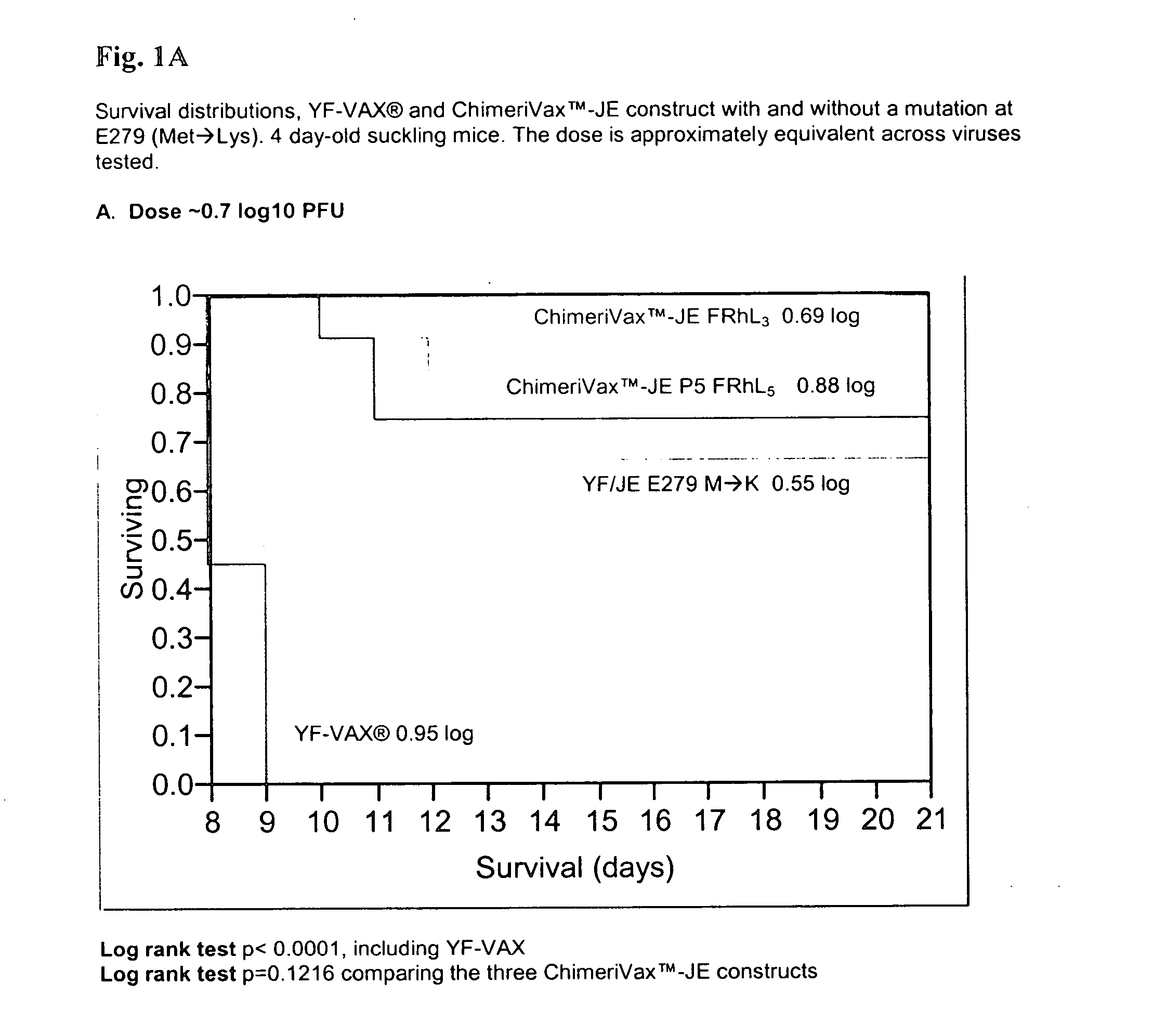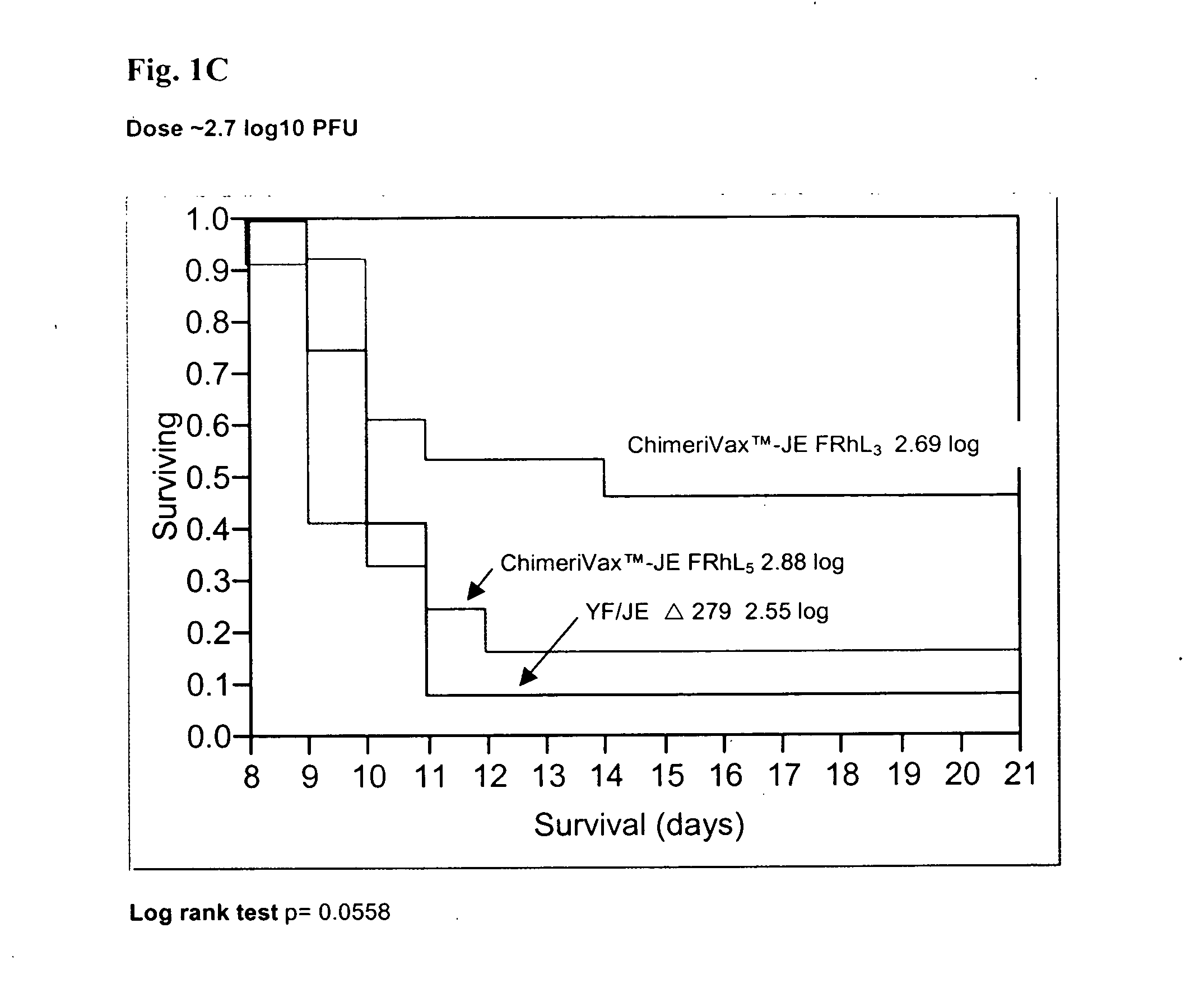Flavivirus vaccines
a technology of flavivirus and vaccine, applied in the field of flavivirus vaccine, can solve the problems of patients treated using these methods and flavivirus infection, and achieve the effects of reducing viscerotropism, promoting immunity, and promoting immunity
- Summary
- Abstract
- Description
- Claims
- Application Information
AI Technical Summary
Benefits of technology
Problems solved by technology
Method used
Image
Examples
experiment 1
[0103] Experiment 1
[0104] A total of 12 (6 males and 6 females), experimentally naive, flavivirus-seronegative rhesus monkeys, 2.7 to 4.3 years of age for males and 2.6 to 5.2 years of age for females, weighing 3.6 to 4.3 kg for males and 3.4 to 4.6 kg for females on the day prior to dosing, was assigned to 3 treatment groups (n=4). Each animal received a single dose (˜5 log10 PFU / 0.5 ml virus in Minimal Essential Medium (MEM) containing 50% fetal bovine serum (FBS)) of each of three viruses via SC injection: Group 1: ChimeriVax™-DEN1 (uncloned virus, Vero P4); Group 2: ChimeriVax™-DEN1 (clone E, Vero P6); and Group 3: ChimeriVax™-DEN1 PMS (clone J). The day of dosing was designated as Day 1. Blood samples were collected predose on Day 1 and on Days 2 through 11 for viremia analysis, and on Day 31 for neutralizing antibody analysis. Prior to assignment to the study, animals had been given a complete physical examination, including abdominal palpation and observations of the conditio...
experiment 2
[0105] Experiment 2
[0106] ChimeriVax™-DEN1 PMS (clone J, P7) and ChimeriVax™-DEN1 VL (P10) (each 5 log10 PFU), as well as YF-VAX® control vaccine (4.7 log10 PFU), were administered (0.25 mL) by injection into the left frontal lobe of 18 experimentally naive, flavivirus-seronegative cynomolgus monkeys (n=6 / group) prescreened to be seronegative to flaviviruses. Monkeys were kept under observation for 30 days post inoculation, then euthanized and necropsied. Selected tissues were removed from all animals and processed to slides prior to histopathological evaluation.
[0107] During the observation period, the monkeys were evaluated for changes in clinical signs (twice daily), body weight (weekly), and food consumption (daily). Clinical signs were assigned scores according to a clinical scoring system, based on the World Health Organization (WHO) requirements for yellow fever virus vaccines (World Health Organization, “Requirements for yellow fever vaccine,” Requirements for Biological Su...
PUM
| Property | Measurement | Unit |
|---|---|---|
| molecular weight | aaaaa | aaaaa |
| volume | aaaaa | aaaaa |
| size | aaaaa | aaaaa |
Abstract
Description
Claims
Application Information
 Login to View More
Login to View More - R&D
- Intellectual Property
- Life Sciences
- Materials
- Tech Scout
- Unparalleled Data Quality
- Higher Quality Content
- 60% Fewer Hallucinations
Browse by: Latest US Patents, China's latest patents, Technical Efficacy Thesaurus, Application Domain, Technology Topic, Popular Technical Reports.
© 2025 PatSnap. All rights reserved.Legal|Privacy policy|Modern Slavery Act Transparency Statement|Sitemap|About US| Contact US: help@patsnap.com



